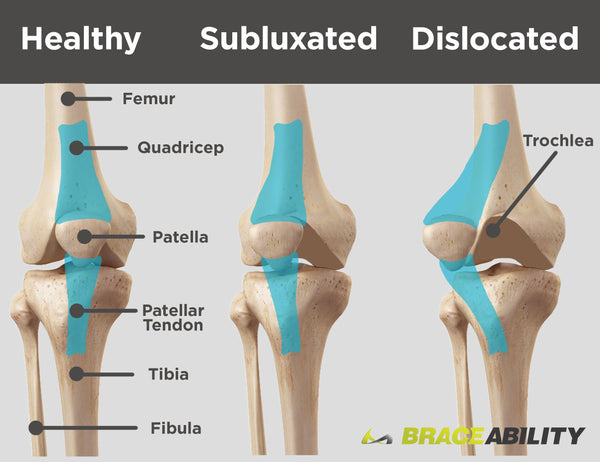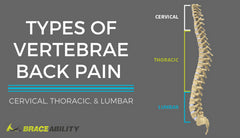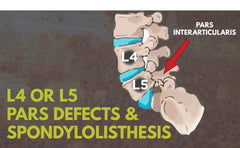Patellar Subluxation (Partially Dislocated Kneecap)
What is Patellar Subluxation?
Patellar subluxation, a patellar tracking disorder, occurs when your patella (kneecap) becomes partially dislocated. Normally, a subluxed patella will return to its normal position by itself. Repeated patellar subluxation, called patellar subluxation syndrome, can damage your cartilage on the back of your kneecap and stretch your connective ligaments.
Although patellar subluxation refers specifically to the partial dislocation of your kneecap, subluxation can occur in other parts of your body. Spine (vertebral) subluxation and hip subluxation are a couple other places in your body where subluxation can occur.

The Anatomy of Your Knee Joint
Usually, your kneecap (patella) rests in a groove (trochlea) at the end of your thigh bone (femur). This groove, commonly called your patellofemoral groove, is located between two bumps at the end of your thigh bone (femoral condyles). Typically, your kneecap should slide up and down, while staying in this groove as your knee bends and straightens.
Picture the groove in your knee joint as a train track and your kneecap as a train. “The train,” your kneecap, should slide up and down and stay on “the train track,” the groove in your knee joint. Patellar Subluxation describes a situation when the train comes partially off its track. This can occur during movement if your kneecap does not stay in its groove, or without any movement if your kneecap does not rest correctly within its groove.
While your kneecap may not come completely out of its groove in your knee joint, your unstable kneecap will still cause knee pain. This occurs most commonly when you walk on uneven terrain, use stairs, or simply roll over in bed. As these activities are repeated, your knee will probably become increasingly irritated and painful.
Subluxation vs. Dislocation of the Kneecap
Patellar subluxation is much more common than patellar dislocation (total knee dislocation). As discussed previously, a patellar subluxation is defined as a partial dislocation of your kneecap. Depending on the severity of your patellar subluxation, improper tracking of your kneecap could lead to dislocation of your kneecap.
A patellar dislocation is typically considered a medical emergency and is usually very painful. This occurs when your kneecap moves or is moved entirely off its groove. Normally, your kneecap is only briefly dislocated and will return to its normal position, followed by swelling and additional pain. This type of dislocation is usually caused by a direct blow to your knee or sudden change in direction when your leg is planted on the ground. Typically, your kneecap will dislocate laterally (towards your outer knee). A patellar dislocation will be felt immediately at the time of your injury, and there will be an obvious displacement of your kneecap.
![]()
The Difference Between Lateral and Medial Knee Subluxation
If you experience a patellar subluxation, your kneecap is likely being pulled towards the outside (lateral side) or inside (medial side) of your knee. When this happens, your kneecap does not slide centrally within its groove as it should. Most people's kneecaps shift too far towards the outside of their leg (lateral subluxation). However, for a select few, their kneecap will shift towards the inside of their leg (medial subluxation).
Why Does the Patella Dislocate Laterally?
Lateral patellar subluxation is much more common than medial subluxation because of your Q angle. A large Q angle pulls your kneecap outwards due to the stronger lateral pull.
The quadriceps angle (Q angle) is the angle formed by one line drawn from your pelvis anterior superior iliac spine to the middle of your patella, and a second line drawn from the middle of your patella to your tibial tubercle. A normal Q angle among men ranges from 8 to 14 degrees. In women, a normal Q angle ranges from 11 to 20 degrees. Women usually have a higher Q angle due to their naturally wider pelvis, meaning they are more prone to experience a patellar subluxation.

Can the Patella Dislocate Medially?
Medial patellar subluxation is a very uncommon form of patellar instability, but it is possible. Medial patellar subluxation is most common after lateral release, a surgical procedure on your knee used to realign your kneecap and prevent lateral patellar subluxation. During this surgery, surgeons must make sure your ligaments are released enough to fix lateral alignment issues. However, sometimes if your ligaments are loosened too much, your kneecap becomes unstable, and it is pulled to the inside of your knee (medial subluxation).
Patellar Subluxation Symptoms
Depending on the severity of your patellar subluxation, the improper tracking of your kneecap might not cause any symptoms for you. In more serious cases, it could lead to a complete dislocation of your kneecap. Most commonly, patellar subluxations feel like your kneecap is shifting or jamming out of place. Patellar subluxation can also cause discomfort with activity, and pain around the front or sides of your kneecap, known as patellofemoral pain syndrome (PFPS).
Besides the sliding of your kneecap to the side, other symptoms of patellar subluxation might include:
- Chronic knee pain that intensifies with movement
- Your knee buckles and cannot support your weight
- Your knee catches during movement
- Stiffness
- Swelling
- Creaking or cracking sounds in your knee
Why Do I Have Patellar Subluxation?
Patella subluxation is probably caused by a number of different things. Ultimately, the contribution of several factors probably leads to instability of your kneecap. For example, if you have experienced a patellar tracking problem in the past, you are automatically more susceptible to patellar subluxations and patellar dislocations of your knee.
Top 4 Causes of Patellar Subluxation
-
Bone structure. If your patellofemoral groove is abnormally shallow or rotated, your kneecap will not have a stable base to rest on.
-
Muscle weakness. Weak muscles surrounding your hip and knee will not properly control the position of your leg, which can lead to instability of your kneecap.
-
Soft tissue malfunction. Your ligaments and tendons also work to hold your kneecap in place. If you are flexible or if you have previously experienced patellar tracking issues, your tissues likely stretch more easily, losing their ability to firmly hold your kneecap in place. In addition, if your soft tissue on the outside of your knee is too tight, it can pull your kneecap out of its proper placement in your patellofemoral groove.
-
Poor movement patterns. Certain movements, such as running or jumping, make your kneecap more susceptible to patellar subluxation.
The Best Ways to Treat Patellar Subluxation
There are many steps you can take to treat kneecap subluxation and address poor kneecap tracking. Firstly, you should make sure that your patella is subluxated and not completely dislocated. Your doctor can determine the position of your kneecap by visually examining your knee and obtaining x-rays, which will show if your kneecap is completely outside of its groove.
Rest
Conservative treatment for mild patellar subluxation involves rest. In addition, you should apply ice and elevate your knee to reduce any painful inflammation (R.I.C.E. treatment). Some people find relief by taking anti-inflammatory pain medications as well.
Physical Therapy and Exercise
Exercise therapy focuses on strengthening the muscles around your hip and knee, which help hold your kneecap in place. Your kneecap, or patella, can sublux out of its normal position more easily when your thigh muscles are weak or unbalanced. If you have underdeveloped inner thigh muscles or overdeveloped outer thigh muscles, it is important to balance those out.
Weight Loss
Weight loss (if applicable) can also help reduce any extra strain on our knees and prevent subluxation of your kneecap. In some cases, weight loss is one of the most important components of treating an unstable kneecap.
Taping
Kinesiology tape (exercise tape) is a good way to help decrease knee pain, support your kneecap, and hold your kneecap in place. It can be used for both the treatment and prevention of patellar subluxation. Learn how to tape for patellar subluxation here.
Knee Braces
Wearing a patellar stabilizer or patellar tracking brace can help your kneecap move properly and prevent patellar subluxation. These braces provide added support around your kneecap. View a variety of patella support braces.
Surgery for Patellar Subluxation
If nonsurgical treatments fail and you experience recurrent kneecap subluxation, you might want to consider surgery to protect your kneecap from subluxation. There are many surgical options to correct patellar tracking disorders. The most appropriate option depends on how severe your condition is and the cause behind your abnormal kneecap positioning. Simply undergoing a surgery, without understanding the specific problem being targeted for correction, can lead to a poor result.
We recommend consulting with your physical therapist and doctor about your condition before contemplating surgical options. Frequently, they will recommend specific exercises, taping, wearing a brace, and resting before suggesting surgery.
Surgical options for patellar subluxation include:
-
One of the most common procedures for patellar subluxation is lateral release surgery. In lateral release surgery, your kneecap is realigned and placed back for normal tracking. In comparison to most surgeries, this arthroscopic surgery is minimally invasive, with just a couple small incisions around your knee.
-
Medical imbrication is another surgical option for patellar subluxation. This procedure helps tighten the tissue on the inner (medial) side of the knee.
-
Medial patellofemoral ligament (MPFL) reconstruction help repair the MPFL, which is commonly torn or injured when the kneecap subluxes or dislocates.
-
The final surgical option we will mention is bone realignment (Fulkerson procedure). Some people have abnormal leg structure. For example, they may have a shallow patellofemoral groove at the end of their thigh bone or strange alignment issues.
Patellar Subluxation Recovery Time
The road to rehabilitation after surgery for patellar subluxation is variable. On average, lateral release procedure is the quickest to recover from, and a bone realignment surgery takes the longest to recover from. Getting your normal stretch and mobility back after surgery for patellar subluxation can take months or possibly even longer. Although it can take awhile to recover, surgery can provide you with relief from patellar subluxation and other patellar tracking disorders.




